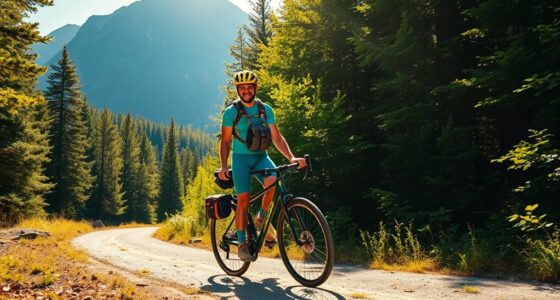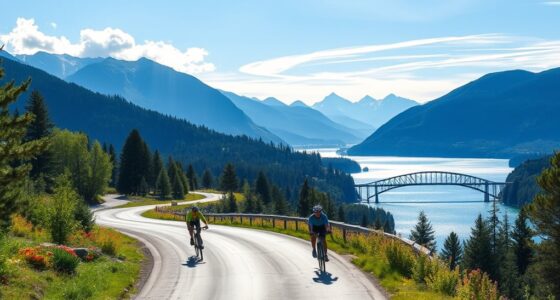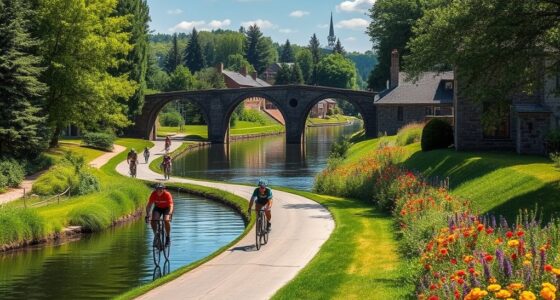To choose the perfect bike for your riding style, start by identifying the type of bike you need, whether it’s a road, mountain, or hybrid bike. Consider the terrain you’ll ride on—paved, off-road, or mixed. Evaluate essential features like frame material, suspension, and brakes to match your preferences. Don’t forget to set a budget that includes potential upgrades and accessories. Want to explore more tips on getting the right fit and maintaining your bike?
Key Takeaways
- Identify your primary riding terrain to select an appropriate bike type, such as road, mountain, or hybrid bikes.
- Consider essential bike features like frame material, suspension system, and brake types that align with your riding style.
- Set a budget and explore various price ranges, from entry-level to high-quality bikes, factoring in additional costs for accessories.
- Assess your comfort and performance needs, such as gearing options and wheel size, to enhance your riding experience.
- Regularly maintain your bike with cleaning, lubrication, and inspections to ensure longevity and optimal performance.
Understanding Different Bike Types
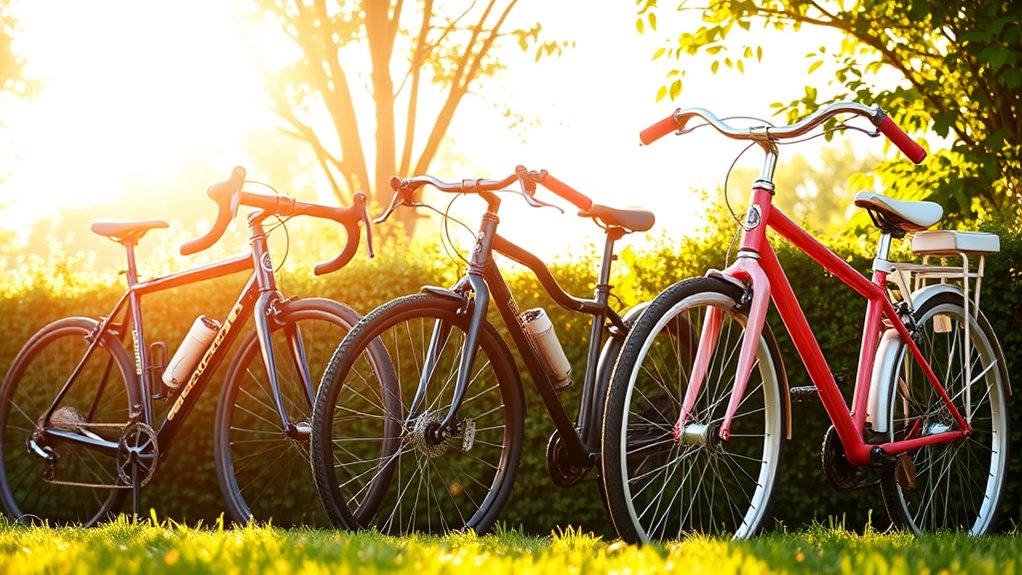
When you’re choosing a bike, how do you know which type is right for you? Understanding the different bike types is essential.
Road bikes excel in speed and efficiency on smooth pavement, featuring lightweight frames and narrow tires.
If you’re tackling rugged terrains, mountain bikes are your best bet, equipped with durable frames and wide, knobby tires for enhanced traction.
For versatility, hybrid bikes combine elements of both, offering comfort with flat handlebars and medium tires.
Specialty bikes cater to specific needs, from BMX for tricks to electric bikes that make pedaling easier.
Each option has unique characteristics that suit different riding styles, so consider your preferences carefully to find the perfect fit.
Considering Your Riding Terrain

As you explore different bike options, considering the terrain where you’ll ride is crucial to finding the right fit.
If you’ll be tackling paved roads, a road bike or electric road bike will maximize your speed. For off-road trails, go for a mountain bike with suspension systems to handle rugged paths.
For swift rides on paved roads, choose a road bike or electric road bike; for rugged trails, opt for a mountain bike with suspension.
If you plan to ride on sandy or snowy surfaces, fat tire bikes offer excellent traction. For mixed terrain, gravel bikes provide versatility for both paved and unpaved roads.
In urban environments, city bikes are perfect for navigating busy streets and obstacles.
Assess the challenges of your terrain, like steep hills or rough trails, to ensure your bike has the right features for optimal performance. Additionally, understanding bike frame materials can help you choose a bike that balances weight and durability based on your riding style.
Evaluating Essential Bike Features
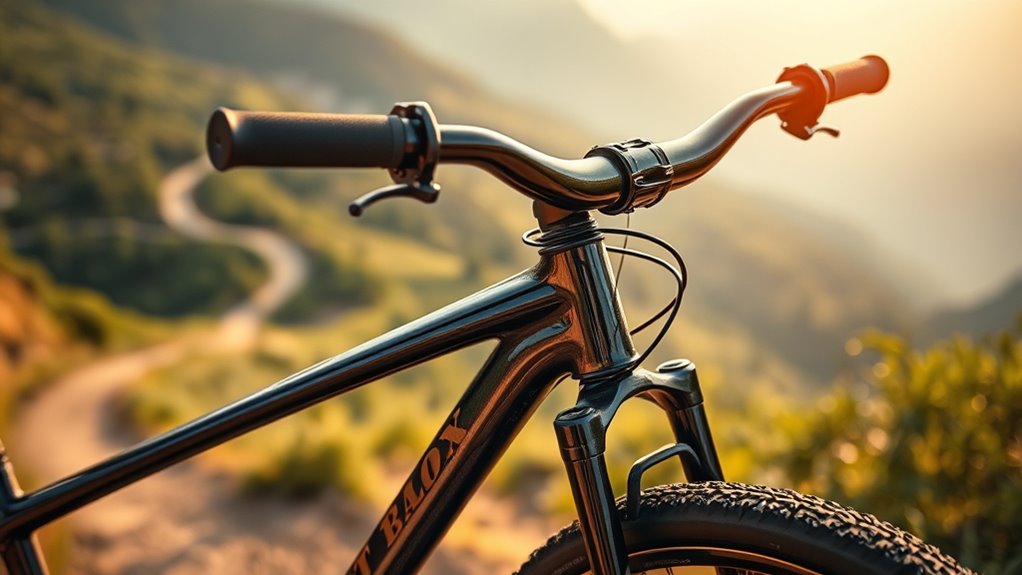
While navigating the bike market, you’ll want to evaluate essential features that can significantly impact your riding experience.
Start with the frame material; carbon fiber offers lightweight performance but comes at a premium. Aluminum is versatile and budget-friendly, while steel provides durability.
Next, consider the suspension system: full suspension enhances comfort on rugged trails, while hardtails are more affordable for smoother paths.
Pay attention to gearing options; more gears give you flexibility across terrains, but can complicate shifting.
Brake systems also matter—disc brakes perform better in wet conditions, while rim brakes are lighter.
Lastly, choose the right wheel size and type, as this affects handling and speed.
Prioritize features that align with your riding style for the best experience.
Assessing Your Budget and Costs
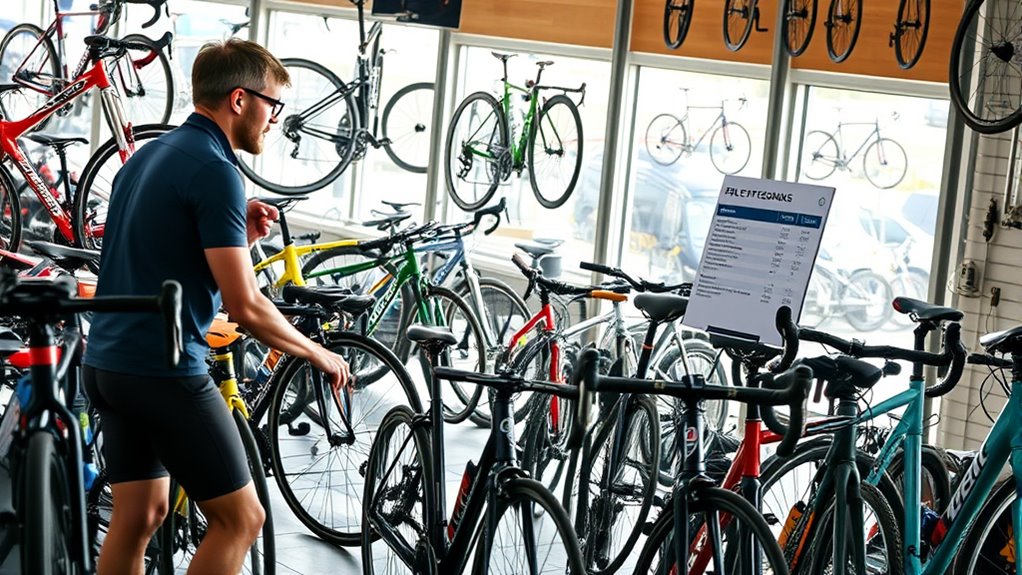
Assessing your budget and costs is crucial for making an informed bike purchase, especially since the market offers a wide range of options at varying price points.
You’ll find entry-level bikes priced between $400 and $600, while mid-range options start around $500 to $750. If you’re looking for high-quality bikes, expect to spend about $1,000. Premium models can soar from $2,000 to $4,000.
Don’t forget to factor in additional costs like accessories, maintenance, and potential upgrades. Look for sales or discounts to stretch your budget further. Utilizing schemes like Cycle to Work can also provide tax benefits.
Consider extra expenses such as accessories and maintenance, and explore discounts or tax-saving programs to maximize your bike budget.
Balancing cost with quality ensures you get a reliable bike that’ll meet your needs for years to come.
Ensuring Proper Fit for Comfort
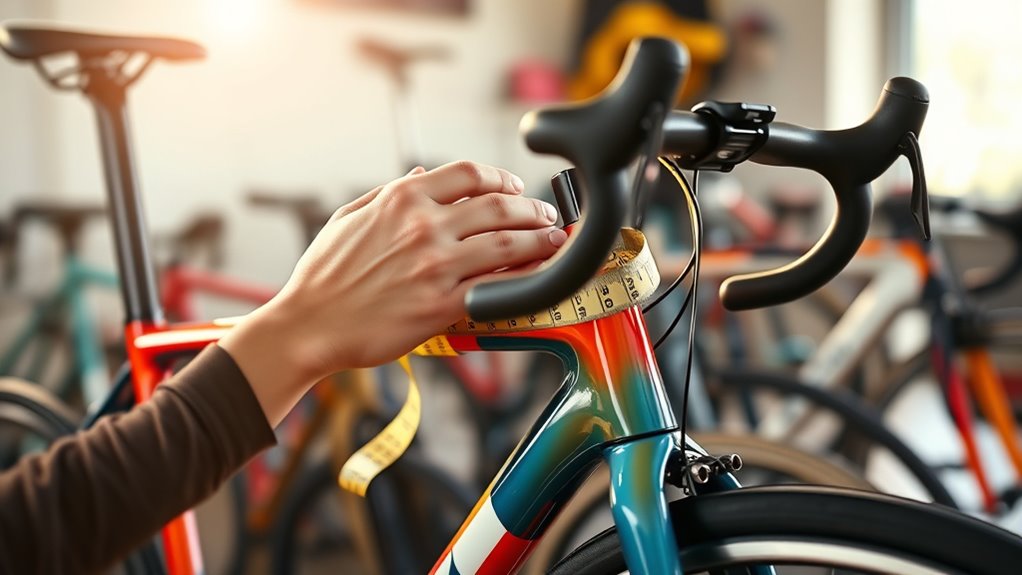
Finding the right fit for your bike is essential to ensure a comfortable and enjoyable ride. A proper bike fit involves adjusting saddle height, handlebar height, and frame size to match your body dimensions and riding style.
When your bike is well-fitted, you’ll experience improved power transfer and efficiency while pedaling. This means fewer pressure points and reduced risk of discomfort or injuries like knee and back pain.
To determine your ideal frame size, consider your height and leg length, and use sizing charts provided by manufacturers. Additionally, adjust key contact points, like saddle position and cleat alignment, to enhance comfort and control.
Investing in a proper fit will make your cycling experience much more enjoyable.
Testing and Demoing Bikes

How can you be sure you’re choosing the right bike? Testing and demoing bikes is the best way to find your perfect match.
Bike shops offer high-performance demo bikes for you to try, allowing you to assess fit, handling, and performance. These bikes are well-maintained, ensuring a top-notch riding experience.
By testing different models, you can discover which suits your riding style and terrain preferences best. Bring your gear, allocate about 40 minutes for each test ride, and engage with shop staff for personalized recommendations.
Don’t forget to take notes on each bike for comparison. Plus, many shops apply demo fees toward a purchase, making it a smart investment in your cycling journey.
Researching Brands and Models
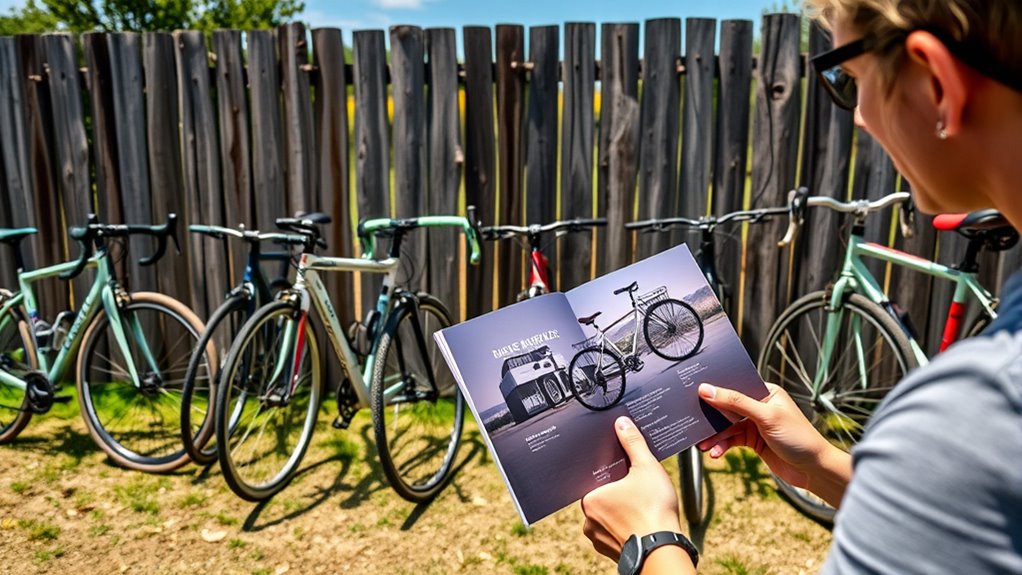
After you’ve tested and demoed bikes, the next step is researching brands and models that align with your riding needs.
Begin by understanding bike categories like road, mountain, gravel, hybrid, and electric bikes. Each serves a unique purpose, so consider where and how you’ll ride.
Understanding bike categories—road, mountain, gravel, hybrid, and electric—helps you choose the right one for your riding needs.
Look into key features like frame material, groupset, tire clearance, brake type, and wheel size. Popular brands like Specialized, Trek, and Giant offer a range of options for various budgets.
Don’t forget to factor in warranties and support, which can be crucial for your investment. With a clear idea of your requirements, you’ll narrow down your choices and find a bike that complements your riding style perfectly.
Maintenance and Care for Longevity
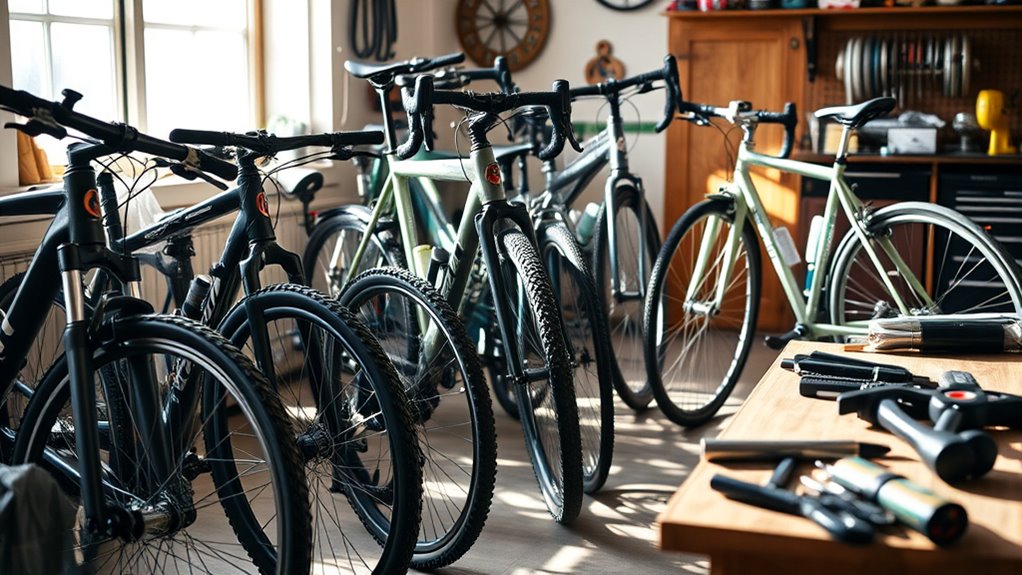
To keep your bike riding smoothly and prolong its lifespan, regular maintenance and care are essential. Start with bolt checks to ensure everything’s tightened, preventing damage.
Clean your bike after rides, especially if you’ve encountered mud, to avoid corrosion. Don’t forget to lubricate the drivetrain according to riding conditions, and inspect your chain for stretch to prevent further damage.
Maintain your brakes by checking their function and replacing worn pads. Keep tires inflated and inspect them regularly for wear.
For e-bikes, monitor battery health by avoiding full discharges. Store your bike in a dry, warm place and consider professional tune-ups every few months. Additionally, regularly checking air pressure during storage can help extend the life of your tires.
Regular attention to these details will keep your bike in top shape for years to come.
Frequently Asked Questions
What Are the Benefits of Owning Multiple Bike Types?
Owning multiple bikes is like having a secret arsenal for every adventure!
You’ll enjoy the right tool for every ride, boosting both performance and comfort. By rotating bikes, you reduce wear and extend their lifespan.
Plus, riding different styles keeps your experience fresh and exciting. With backup options and specialized comfort, you’ll never face a dull moment.
Just imagine the conversations you’ll spark in the riding community with your diverse collection!
How Often Should I Replace My Bike Tires?
You should replace your bike tires every 1,500 to 5,000 kilometers, depending on the type and usage.
Additionally, consider replacing them every three to five years to prevent rubber degradation.
Keep an eye out for signs of wear like worn tread, gashes, or dry rot.
If you notice a decrease in traction or handling, it’s definitely time for a change.
Regular inspections will help you catch issues before they become serious.
Can I Modify My Bike After Purchase?
Did you know that about 60% of cyclists modify their bikes after purchasing? Yes, you can definitely modify your bike post-purchase!
Upgrading components like tires, brakes, or shifters can enhance your riding experience. Just make sure any modifications align with your riding style and goals.
Local bike shops offer expertise to ensure compatibility and safety, helping you achieve the optimal performance you’re looking for.
What Accessories Do I Need for Safe Riding?
For safe riding, you need essential accessories.
Start with a properly fitting helmet for head protection. Add high-powered front and rear lights to ensure you’re visible in low light. Reflective gear boosts your visibility further.
Don’t forget a loud bell or horn to alert others. Carry a basic first aid kit for minor injuries.
Lastly, invest in a good bike lock to secure your ride when parked, preventing theft and giving you peace of mind.
How Can I Improve My Cycling Skills?
You might think improving your cycling skills is just about time on the bike, but it’s more than that.
Start with drills like riding a straight line or doing figure eights to sharpen your balance and cornering. Incorporate starts and stops for better control, and practice bunny hops to tackle obstacles.
Group rides can enhance your drafting skills, too. Consistency is key, so make these practices a regular part of your routine.
Conclusion
Now that you’ve explored the different bike types and considered your riding style, the excitement builds as you prepare to make your choice. Will you conquer rugged trails or glide through city streets? Remember, the perfect bike is out there, waiting just for you. Take your time, test a few, and let the right one speak to your adventurous spirit. You’re one ride away from unforgettable journeys—are you ready to discover what awaits?


